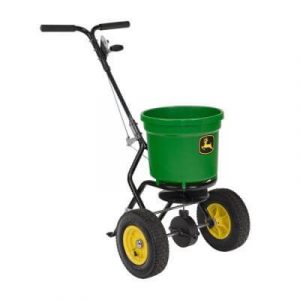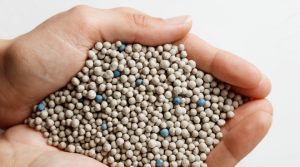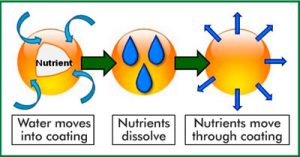Tom Jones may well have sung about the green green grass of home, far too few gardeners understand what goes into the perfect lawn. Most think it is okay to pick up a bag of feed, sprinkle it liberally on the lawn and all will be okay. Your lawn has a complex relationship with nutrition, which changes throughout the growing season and these things need to be taken into consideration if you want a healthy, attractive, disease free lawn.

calibrate your fertiliser spreader before using it
You may be thinking that surely it can’t be that complicated. Let’s try to explain the basics. When it comes to lawn nutrition there are really three main things to think about; fertiliser composition, timing and application methods.
Why is lawn fertiliser important?
Fertilisation is important as it influences the colour of your lawn, its ability to cope with the stresses of drought, mowing and extremes of temperature and to fight against disease and weed infiltration. Choosing the right fertiliser and applying it correctly really is the key to success.
Chemical and organic fertilisers display the nutrient content by way of three different numbers. These three numbers represent the compounds Nitrogen, Phosphorus and Potassium (or Potash). Often displayed as N-P-K. The numbers correspond to the percentage of each of these compounds in the fertiliser inside the pack. That’s the easy bit! What each of these compounds does for the plant is probably the most important part.

Buy high quality lawn fertiliser
Nitrogen helps leaf growth. Phosphorus helps the growth of roots and flowers, and Potassium is important for the overall health of the plant. When to promote leaf or root growth is really the key to successful lawn nutrition. You want healthy leaf growth in the growing season to encourage a stronger grass plant, but you don’t want to go into winter with too much leaf that can be damaged by the bad weather.
High nitrogen fertilisers encourage quick leaf growth but potentially make the plant more susceptible to the attacks of pests and diseases. Phosphorus is important going into winter to encourage healthy and robust roots to support your lawn throughout the challenging months ahead.
What is slow-release fertiliser?
Another important factor in selecting the right lawn fertiliser is the type of nitrogen actually in the product. Nitrogen fertiliser may consist of fast-release or controlled-release nitrogen. For lawns, fertilisers containing controlled-release nitrogen sources are best. Lawn care professionals tend to use coated granular product. The coating is formulated to break down gradually over time, therefore providing a slow release of fertiliser as the plants require it. It tends to be more expensive but it certainly is effective, provides professional results and gradual grass growth, rather than a sudden burst of growth resulting in excess mowing requirements.

Control the release of lawn nutrition
So we have covered composition and also timing of application. Let’s take a look at application methods.
Most home owners who buy their lawn feed from the garden centre will have a choice between granular or liquid feeds. As we mentioned earlier, ideally you want a product that releases its nutrients into your lawn slowly, as required, over time. There are two downsides to liquid feeding. The first is that it is immediate. Your lawn gets an instant food hit then nothing. The other issue is that liquid feeding can be very time consuming and it’s difficult to get the application rates right. However liquid feeds come into their own in the summer months – no need to water in!
Controlled-release granular feed is by far the best choice when you can guarantee a regular supply of rain. Most gardeners will attempt to apply this themselves and this can create issues. Application by hand is almost impossible to get right. The granules slip through your fingers easily and distribution is uneven. Apply too much to one area and you scorch the grass, often blackening or killing it in patches. Uneven application results in uneven grass growth.
Ideally use is a broadcast spreader consisting of a hopper holding the fertiliser and releasing a controlled amount onto a rotating disk, powered by the forward movement of the wheels, distributing the granules in a controlled and even manner. The amount of fertiliser released is controlled by adjusting holes in the base. Getting the quantities right is important and you must calibrate the spreader before you use it, based on the flow rate of the fertiliser, the granule size, the application rate required and the size of the hopper holes. It’s important not to miss any of the lawn or to overlap as you make each pass with the spreader.
One final thing to remember is that too much nitrogen causes thatch which starves your lawn of air and water causing the grass to die. Get it wrong and your lawn really will pay the price.
I’ve tried to make things as simple as possible but lawn nutrition, product selection and application rates can be relatively complicated. By the time you have bought the product, the right applicator and factored in the time it takes to carry out the work, you can usually save money by asking a lawn care professional to help look after this part of your garden for you. After all, if you want professional results then a professional is usually the person to ask.

 Established 2016
Established 2016



